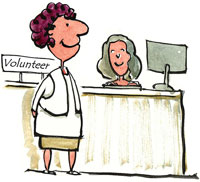
A group of retired and semi-retired professional women – lawyers, teachers, corporate execs, etc. – was inspired to do something concrete and useful to better the status of women. After much research, they were surprised to learn that sex trafficking is alive and rampant in their home city, New York. Reducing that become their focus, with ideas ranging from advocacy to picketing publications that thrive on sex ads. They were rarin’ to go.
But being experienced, they decided to work with an existing agency rather than reinvent the wheel. They contacted groups directly and through the Mayor’s Volunteer Center. “Tell your friends” and “donate money” were the two options given to them. The former they did, spearheading a meeting at which a speaker discussed the extent of sex trafficking and the lack of enforcement.
Yet, again, no concrete suggestions for employing the skills and voices of these women. Picketing? Trips to City Council? Bringing the subject up at their local precinct meeting? No, no, and no.
Yet isn’t that just what advocacy needs? More voices, more presence, more articulate people raising questions at city hall and in Albany? What a wasted opportunity!
Not unlike the experience of another friend, skilled as a paid peer counselor for survivors of domestic violence. She called, emailed, and snail-mailed every DV agency in New York City, offering to volunteer, and got no response. When she did train for emergency response at a hospital, the promised “morning after mandatory counseling” of volunteers turned out to be an answering machine no one ever picked up.
Frustrated because she was flying solo even when she had real concerns about ER and police behavior, she quit.
Another woman trained to be help those with no support system – seniors primarily – navigate the heath care system, from advocating for them in hospital to ensuring that they had the help they needed when discharged. The program was canceled, in part because hospital administrators weren’t keen on it.
Why, in this era of budget cuts and increased needs for services are nonprofits disdaining the use of volunteers? Baby boomers are loathe to sit back and relax even after they retire. Their eagerness goes beyond the old vision of volunteers stuffing envelopes – or in the 21st century, sending emails. They want to organize, design, implement, and strategize about big ideas. They want to work one-on-one with clients, be part of a team, do something that makes a difference.
They want to matter.
The Taproot Foundation understands this about professionals of all ages. Founded in 2001, it became the largest nonprofit consulting firm in the nation in just five years. All volunteer. All about professional services. But also all about corporate-sponsored pro bono work.
What about the groups of people outside the corporation, already retired? Among them are bankers who could help design social impact financial products, managers who could plan advocacy actions, social workers who could help develop programs or people of varied skills who could help clients learn to read or get in-home health care.
Why are nonprofits dissing these folks?
I can think of a number of reasons:
- Volunteer programs require planning and maintenance; they’re time-consuming to get off the ground.
- Younger managers may feel uncomfortable with older volunteers and so don’t integrate them into the team.
- Older volunteers may be viewed as out of date or out of energy.
- Experienced volunteers may, rightly or wrongly, be viewed as wanting too much power and be reluctant to do things “the nonprofit way.”
- Many volunteer programs are designed for the summer intern, the student who will come, work horrible hours, learn a lot, and leave with the seeds of social consciousness planted.
Are those insurmountable obstacles to tapping into this reservoir of talent? I don’t think so. Next week, I’ll tell you why and how you do it.
What has your experience been as a volunteer? Using volunteers? Any tips?
Flickr image: By HikingArtist.com
